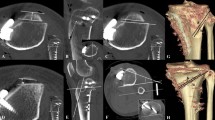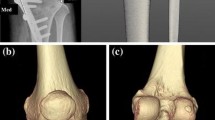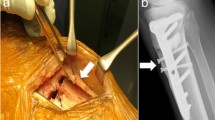Abstract
Purpose
The purpose of this study was to investigate the causes of retro-tubercular gap widening and to confirm whether this widened gap causes instability of the osteotomy configuration during open-wedge high tibial osteotomy (OWHTO).
Methods
Operative records and radiologic findings of patients who underwent biplanar medial OWHTO between 2014 and 2016 were retrospectively evaluated. To identify the osteotomy configuration including lateral hinge fracture, postoperative simple radiographs and CT images were analyzed. Postoperative CT scan was used to evaluate the widening of the retro-tubercular gap, thickness, and axial angle of retro-tubercular osteotomy, as well as the ratios of anterior and posterior osteotomy, and hinge length. The correlation of each factor was evaluated and analyzed in accordance with the lateral hinge fracture (LHF).
Results
Widening of the retro-tubercular gap showed a significant correlation with the axial angle of retro-tubercular osteotomy, anterior osteotomy ratio, and opening gap distance, but not with the thickness of retro-tubercular osteotomy, posterior osteotomy ratio, and hinge length ratio. The LHF group showed significantly larger value than the non-LHF group with respect to the thickness of retro-tubercular osteotomy (P = 0.003), axial angle of retro-tubercular osteotomy (P = 0.033), retro-planar gap distance (P = 0.001), anterior osteotomy ratio (P = 0.000), and opening gap distance (P = 0.003). The hinge length ratio was smaller in the LHF group than in the non-LHF group (P = 0.001). However, the posterior osteotomy ratio was not different between the two groups (n.s.).
Conclusion
Retro-tubercular gap widening can be caused by inappropriate anterior osteotomy and large opening gap distance, which can be related to LHF. Therefore, anterior cortical osteotomy may also be an important factor for preventing instability of the proximal fragment in biplanar OWHTO.
Level of Evidence
Case–control study, Level III.




Similar content being viewed by others
References
Baumgarten KM, Meyers KN, Fealy S, Wright TM, Wickiewicz TL (2007) The coronal plane high tibial osteotomy. Part II: a comparison of axial rotation with the opening wedge high tibial osteotomy. HSS J 3(2):155–158
Hinterwimmer S, Feucht MJ, Paul J, Kirchhoff C, Sauerschnig M, Imhoff AB, Beitzel K (2016) Analysis of the effects of high tibial osteotomy on tibial rotation. Int Orthop 40(9):1849–1854
Hohmann E, Bryant A, Imhoff AB (2006) The effect of closed wedge high tibial osteotomy on tibial slope: a radiographic study. Knee Surg Sports Traumatol Arthrosc 14(5):454–459
Jacobi M, Villa V, Reischl N, Demey G, Goy D, Neyret P, Gautier E, Magnussen RA (2015) Factors influencing posterior tibial slope and tibial rotation in opening wedge high tibial osteotomy. Knee Surg Sports Traumatol Arthrosc 23(9):2762–2768
Jang KM, Lee JH, Park HJ, Kim JL, Han SB (2016) Unintended rotational changes of the distal tibia after biplane medial open-wedge high tibial osteotomy. J Arthroplasty 31(1):59–63
Kendoff D, Lo D, Goleski P, Warkentine B, O’Loughlin PF, Pearle AD (2008) Open wedge tibial osteotomies influence on axial rotation and tibial slope. Knee Surg Sports Traumatol Arthrosc 16(10):904–910
Lee BH, Ha CW, Moon SW, Chang M, Kim HY, Park SH, Wang JH (2017) Three-dimensional relationships between secondary changes and selective osteotomy parameters for biplane medial open-wedge high tibial osteotomy. Knee 24(2):362–371
Lee OS, Lee YS (2017) Diagnostic value of computed tomography and risk factors for lateral hinge fracture in the open wedge high tibial osteotomy. Arthroscopy 34:1032–1043
Lee YS, Kang JY, Lee MC, Elazab A, Choi UH, Kang SG, Lee KJ, Lee S (2017) Osteotomy configuration of the proximal wedge and analysis of the affecting factors in the medial open-wedge high tibial osteotomy. Knee Surg Sports Traumatol Arthrosc 25(3):793–799
Lee YS, Kang JY, Lee MC, Oh WS, Elazab A, Song MK (2016) Effect of the osteotomy length on the change of the posterior tibial slope with a simple distraction of the posterior gap in the uni- and biplanar open-wedge high tibial osteotomy. Arthroscopy 32(2):263–271
Lee YS, Moon GH (2015) Comparative analysis of osteotomy accuracy between the conventional and devised technique using a protective cutting system in medial open-wedge high tibial osteotomy. J Orthop Sci 20(1):129–136
Lobenhoffer P, Agneskirchner JD (2003) Improvements in surgical technique of valgus high tibial osteotomy. Knee Surg Sports Traumatol Arthrosc 11(3):132–138
Noyes FR, Goebel SX, West J (2005) Opening wedge tibial osteotomy: the 3-triangle method to correct axial alignment and tibial slope. Am J Sports Med 33(3):378–387
Pape D, Lorbach O, Schmitz C, Busch LC, Van Giffen N, Seil R, Kohn DM (2010) Effect of a biplanar osteotomy on primary stability following high tibial osteotomy: a biomechanical cadaver study. Knee Surg Sports Traumatol Arthrosc 18(2):204–211
Rodner CM, Adams DJ, Diaz-Doran V, Tate JP, Santangelo SA, Mazzocca AD, Arciero RA (2006) Medial opening wedge tibial osteotomy and the sagittal plane: the effect of increasing tibial slope on tibiofemoral contact pressure. Am J Sports Med 34(9):1431–1441
Song EK, Seon JK, Park SJ (2007) How to avoid unintended increase of posterior slope in navigation-assisted open-wedge high tibial osteotomy. Orthopedics 30(10 Suppl):S127-131
Sterett WI, Miller BS, Joseph TA, Rich VJ, Bain EM (2009) Posterior tibial slope after medial opening wedge high tibial osteotomy of the varus degenerative knee. J Knee Surg 22(1):13–16
Suero EM, Hawi N, Westphal R, Sabbagh Y, Citak M, Wahl FM, Krettek C, Liodakis E (2017) The effect of distal tibial rotation during high tibial osteotomy on the contact pressures in the knee and ankle joints. Knee Surg Sports Traumatol Arthrosc 25(1):299–305
Takeuchi R, Ishikawa H, Kumagai K, Yamaguchi Y, Chiba N, Akamatsu Y, Saito T (2012) Fractures around the lateral cortical hinge after a medial opening-wedge high tibial osteotomy: a new classification of lateral hinge fracture. Arthroscopy 28(1):85–94
Teeter MG, Leitch KM, Pape D, Yuan X, Birmingham TB, Giffin JR (2015) Radiostereometric analysis of early anatomical changes following medial opening wedge high tibial osteotomy. Knee 22(1):41–46
Turkmen F, Kacira BK, Ozkaya M, Erkocak OF, Acar MA, Ozer M, Toker S, Demir T (2016) Comparison of monoplanar versus biplanar medial opening-wedge high tibial osteotomy techniques for preventing lateral cortex fracture. Knee Surg Sports Traumatol Arthrosc 25(9):2914–2920
Funding
This study has been supported by Basic Science Research Program through the Ministry of Education of the Republic of Korea and National Research Foundation of Korea (NRF) (NRF-2017R1D1A1A09000509).
Author information
Authors and Affiliations
Corresponding author
Ethics declarations
Conflict of interest
The authors declare that they have no conflict of interest.
Ethical approval
The study protocol was approved by the institutional review board of our hospital (SNUBH, B-1409/266-104).
Informed consent
For this type of study, formal informed consent was not required.
Rights and permissions
About this article
Cite this article
Jo, I.H., Lee, OS., Lee, S.H. et al. Retro-tubercular gap widening can be caused by inappropriate anterior osteotomy and large opening gap in the medial biplanar open-wedge HTO. Knee Surg Sports Traumatol Arthrosc 27, 2910–2916 (2019). https://doi.org/10.1007/s00167-018-4991-6
Received:
Accepted:
Published:
Issue Date:
DOI: https://doi.org/10.1007/s00167-018-4991-6




